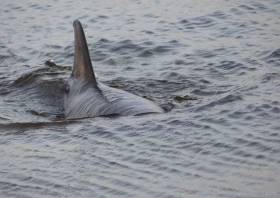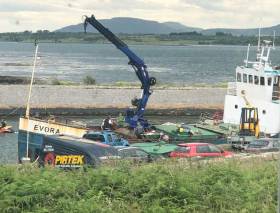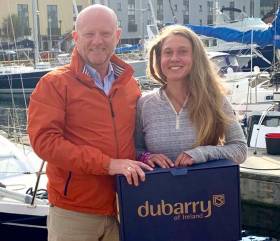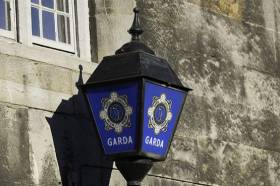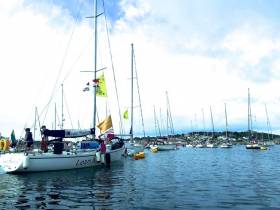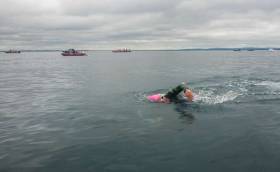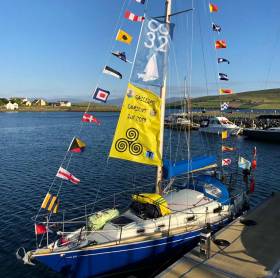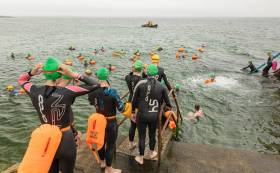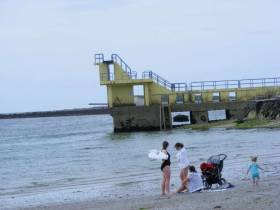Displaying items by tag: Galway Bay
'Cumar – a Galway Rhapsody' Docu Wins Award in London this Week
Galway’s “edge of the world” situation between river, lake and sea has inspired a documentary which secured a top award earlier this week at the Irish Film Festival London writes Lorna Siggins
The documentary entitled Cumar – a Galway Rhapsody explores the influences of Connemara’s Atlantic landscape and Galway on seven artists, including musician/composer Máirtín O’Connor, poet/playwright Rita Ann Higgins and novelist Mike McCormack.
Macnas performance company artistic director Noeline Kavanagh, singer-song-writer, RóisínSeoighe, visual artist, Pádraic Reaney and comedian, Tommy Tiernan were also profiled in the documentary.
Described as “Galway’s own cinematic sean-nós” by Ronan Doyle of independent film website Scannáin, it was conceived and directed by Aodh Ó Coileáin of NUI Galway and produced by Paddy Hayes of Tua Films.
It had its premiere at this year’s Galway Film Fleadh in July and was screened in Chicago, USA, in September.
“It is of particular significance to be selected for this award in London, a city so central to Irish artistic endeavour,” Ó Coileáin said.
“Since coming to live in Galway over 30 years ago, I have wondered what it is about this catchment area that produces artists and attracts artists to the city of tribes,” Ó Coileáin, from Co Kerry, says.
“The film touches on some of the explanations that have occurred to me from time to time: the city’s diverse cultural background stretching into medieval times and beyond, the confluence of languages, the rich tradition of music and song… or is it simply the meeting of the waters: river, lake, and sea?”
He recalled how many west of Irish musicians and artists came to London to work in the years after the second world war, including Joe Heaney from Carna, Co Galway, piper Willie Clancy and fiddle player Bobby Casey from Co Clare, and singer Margaret Barry from Cork.
He recalled that Druid Theatre company’s performance of J M Synge’s The Playboy of the Western World at the Donmar Warehouse in London’s Covent Garden in 1985 was a “milestone in Irish theatre”.
Irish Film Festival London founder and director Kelly O’Connor predicted that Cumar would become a “long-standing document of the intrinsic essence and influence of Galway”.
Galway composer Jake Morgan wrote the documentary’s score, while Galway Street Club made a guest appearance.
The film will be screened at London’s Regent Street Cinema as part of the Irish Film Festival London on November 24th at 7.30 pm.
The documentary is an ilDána film, funded by TG4 and the Arts Council, in association with Galway Film Centre.
A bottlenose dolphin was recently rescued by quick-thinking locals after live stranding on Mutton Island near Galway city.
The Irish Whale and Dolphin Group (IWDG) reports the story related to it by friend of the group Jason, who was alerted to the marine mammal in the shallow water near the Galway Bay lighthouse by an Australian couple with whom he had previously been discussing the area’s resident bottlenose Nimmo.
“I just knew it was in trouble so I ran down and the dolphin was out of the water alive,” he said.
With the tide going out, time was of the essence as Jason was joined by three others who offered their scarves to form a brace to lift the dolphin into deeper water.
“I just went the rest of the way as it was getting dark at that point. With one final push it just started to swim away.
“I can’t explain how I felt and we did it as a team. An incredible thank you so so much to those who helped,” he added.
The incident came just days after the IWDG called on the Government to join forces with NGOs like itself to develop a stranding response protocol, especially for large whales.
The IWDG said “fresh attention” has been drawn to the issue following the death of a fin whale seen swimming in Dublin Port earlier this month.
More recently, an endangered sei whale was found floating in the River Thames at Gravesend in the UK last Friday (18 October), nearly two weeks after a humpback whale died in the same stretch of water.
IWDG chief executive Dr Simon Berrow said: “Strandings, both live and dead, of large whales are not common in Ireland but do occur and we need a protocol, signed off by relevant partners, including Government agencies, so we can respond quickly and efficiently in such cases without having to phone around looking for resources and support.”
Damaged Ship Still Being Detained Near Kinvara, Co Galway
Irish authorities are still detaining a cargo ship close to Kinvara in south Galway Bay after its hull sprang a leak while loading cargo for the Bahamas writes Lorna Siggins
As Afloat reported previously, the 30m ship Evora was detained last week at Tarrea pier near Kinvara by the Marine Survey Office (MSO) under port-state control regulations which prevent the vessel from going to sea.
Concerns about the four crew employed for the voyage also prompted a visit to the vessel by the International Transport Federation’s (ITF) Irish branch.
ITF representative Michael Whelan said he had met the crew – three Cubans and a Colombian – to check on their situation in relation to pay, conditions, and accommodation for the crew while the vessel is damaged.
The cargo ship had been due to steam to the Bahamas with a large quantity of cement when the ship’s hull was damaged during loading at Tarrea pier.
Local residents feared that fuel from the ship might leak, causing pollution which would have a serious impact on south Galway’s shellfish industry, including its oyster beds.
The owner said there had been no fuel leak from the vessel and no pollution risk.
The pier is outside the remit of the Galway harbourmaster and is the responsibility of Galway County Council.
It is understood residents found it difficult to get a response from the local authority, and Galway harbourmaster Capt Brian Sheridan intervened to assist.
The Department of Transport, under which the Marine Survey Office operates, said it could not comment on the details of the detention.
It said that any queries should be directed to the ship’s flag state – as in Saint Vincent and the Grenadines. However, the ship's port of registry is recorded as Panama on the vessel.
The vessel, built in France 50 years ago, was formerly owned in Rossaveal, Co Galway, but was sold to a new owner within the past 12 months.
The owner confirmed that the vessel had been held as the engine room was flooded, and said: "no harmful substances were released into the bay".
The ITF representative Michael Whelan said he was in regular contact with the crew, and understood they now wished to be repatriated. He confirmed that the crew had been paid, but did not wish to stay indefinitely, as the vessel had not been inspected by flag state inspectors as of yesterday.
Dubarry Supports Belgian Solo Sailor in Galway
Belgian solo sailor Caroline Adriens has departed southwards from Galway after spending nearly a year in the popular west coast port with her 30ft Albin Ballad.
She had arrived in Galway in September 2018 from Tromsø in Norway via Shetland, Orkney, Cape Wrath, the west coast of Scotland, Northern Ireland, northwest Ireland and the coast of Connacht before mooring up in Galway for the winter in the welcoming shelter of the dock.
Her boat, a classic Albin Ballad, is of a successful and seaworthy marque that was built in Sweden between 1971 and 1982 and has now been overhauled in Galway in advance of her dream to sail around the world.
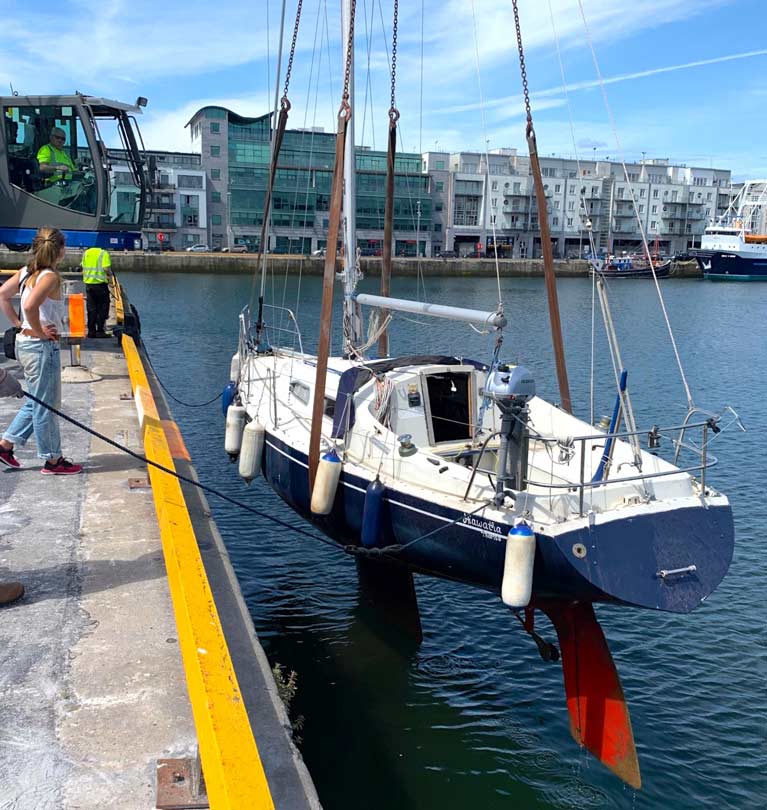 Hiawatha in the slings in Galway, Caroline Adriens on left
Hiawatha in the slings in Galway, Caroline Adriens on left
Caroline said of her plans that: “It’s an itch that I’ve wanted to scratch for quite some time, and I’m finally realising my dream when I depart from Galway.
It will be the first time that I have actually sailed on my own. I'm excited, but of course a little nervous, as the ocean is a big place and my boat is not so big".
On hearing of Caroline's impending trip, Michael Walsh of Dubarry wasted no time in supporting Caroline with a pair of Shamrock Sailing Boots to ensure she departed Galway with the best women's sailing footwear on the market.
Caroline plans to be in Portugal for the winter via the Scilly Isles in early September, and has reached Valentia Island in Kerry by way of Fenit on Tralee Bay in the first stages of her voyage southward.
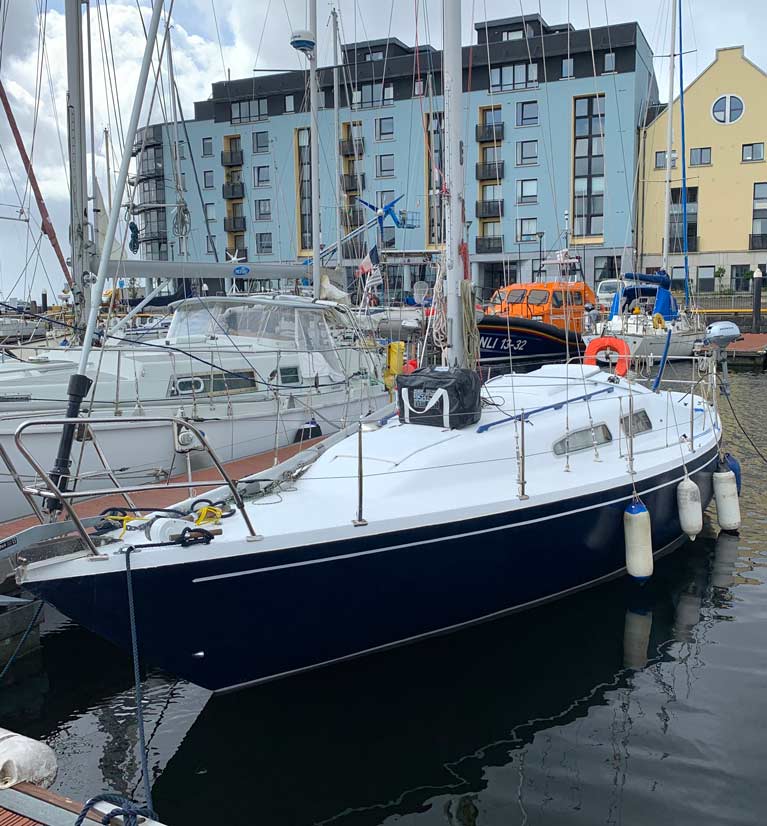 Belgian solo sailor Caroline Adriens’ Hiawatha is a well-proven Albin Ballad built in Sweden in the 1980s
Belgian solo sailor Caroline Adriens’ Hiawatha is a well-proven Albin Ballad built in Sweden in the 1980s
Gardai Investigate Drowning Incident Off Salthill
A man has died after getting into difficulty swimming in Galway Bay yesterday (Friday 23 August).
Independent.ie reports that the man aged in his late 70s had been swimming off Salthill around noon yesterday when he got into difficulty.
His body was recovered by a lifeguard and the scene was attended by emergency services but he was not revived.
Gardai say a file on the incident will be prepared for the Coroner’s Court.
Even the most experienced amateur sailors will always feel a certain nervousness mingling with the anticipation in starting a cruise writes W M Nixon. This is particularly so when the cruise will take them out of sight of land, and through nights at sea. Yet it brings its rewards, and today an impressive and varied fleet of 27 cruising boats, mostly from Ireland’s western seaboard, will be gathering in Lorient in Brittany after a 553-mile cruise-in-company along exposed coasts and across open ocean from Galway Bay, a joint venture which got underway a week ago.
For many “Nervous Novices”, the notion of broadening one’s seagoing experience through mutually-supportive Cruises-in-Company has an obvious appeal. This concept has been central to the thinking of some noted movers and shakers in Galway Bay Sailing Club and along the west coast. They’ve become increasingly keen in recent years to re-invigorate the maritime links which focused on the connections between Galway and Lorient, the main port in southern Brittany, which is best known to non-sailors as the host town of the annual Inter-Celtic Festival, whose visitors have included President Michael D Higgins.
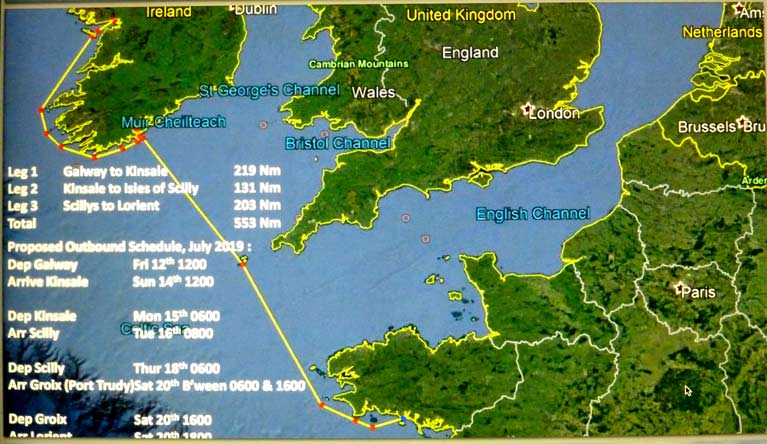 The basic track chart allows room for diversions in the home waters of the Celtic Fringe, along what most sailors from elsewhere would see as distinctly rugged coastlines
The basic track chart allows room for diversions in the home waters of the Celtic Fringe, along what most sailors from elsewhere would see as distinctly rugged coastlines
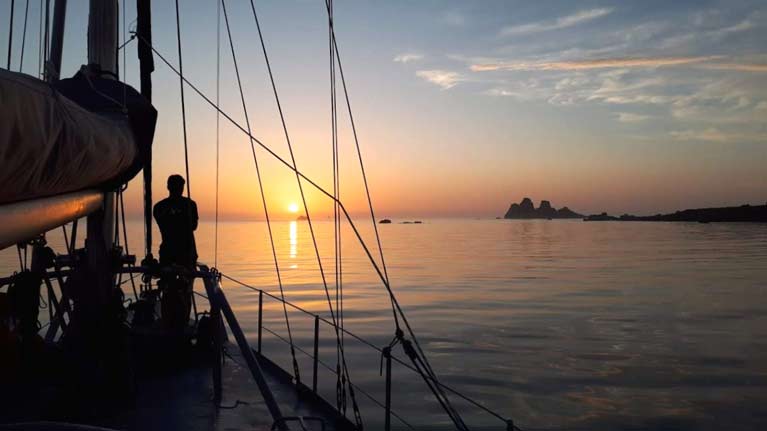 To date, the Cruise-in-Company has enjoyed mostly gentle weather, including perfect sunrises and sunsets which emphasise the special nature of the coastlines they’re visiting
To date, the Cruise-in-Company has enjoyed mostly gentle weather, including perfect sunrises and sunsets which emphasise the special nature of the coastlines they’re visiting
The sailing links were particularly active during the 1970 and ’80s, with regular inter-changes of boats and people, while the existence of a now re-focused Glenans Ireland base in Clew Bay played its role. But since then, the visible lines of sailing communication between Ireland and Brittany have tended to take on a more professional flavour, with major events setting the pace, such as the Volvo Ocean Race, the Figaro, and the fact that French boats have registered so much success in the Round Ireland and Fastnet Races.
Yet the memories of those more informal amateur contacts, based on genuine friendship across the sea and along the Celtic coasts between two formally-linked Atlantic ports, have never faded. And while Galway sailing’s busy folk such as the always-innovating Cormac Mac Donncha have seen much of their energy taken up with events such as the first staging of the WIORA Championship in the Aran Islands - it happened with great success in 2017 with a remarkable 44 boats taking part - the seeds of the idea of a new Galway-to-Brittany Cruise-in-Company, planted by Galway’s Enda O Coineen, were beginning to take root.
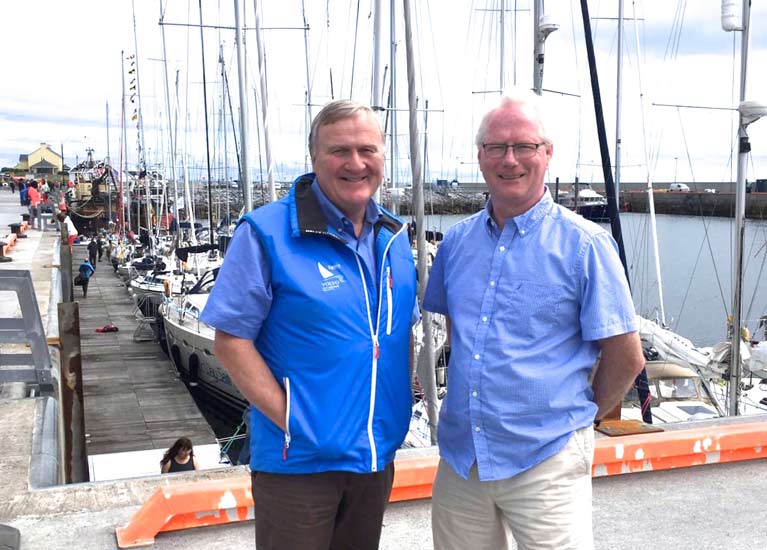 Irish Sailing President Jack Roy (left) with GBSC’s Cormac Mac Donncha at the WIORA Championship in the Aran Islands, July 2017
Irish Sailing President Jack Roy (left) with GBSC’s Cormac Mac Donncha at the WIORA Championship in the Aran Islands, July 2017
Cormac Mac Donncha soon found fellow-enthusiasts among GBSC clubmates such as John Killeen, Pierce Purcell and Johnny Shorten and others. Then, too, the international connections of Enda O’Coineen – particularly along the coast of France following his Vendee Globe involvement and Figaro support programmes – have proven invaluable in ensuring that if they managed to get a fleet together, there would be proper reception arrangements in place at each port to make them welcome and cater for their needs.
The links across the sea were also developed at more official levels building on the connections between the Mayor of Galway Mike Cubbord and his counterpart in the twinned arrangement with Lorient which has been in place since 1975, with Catherine Gagneux of the French Consulate in Galway much involved, and back on water the active support of Jean-Gab Samzun, President of Lorient YC and a frequent visitor to Cork Week, was also readily forthcoming and his 46ft S&S-designed former Admirals Cupper Trilogy is one of the three French boats which came to Galway to join in the venture.
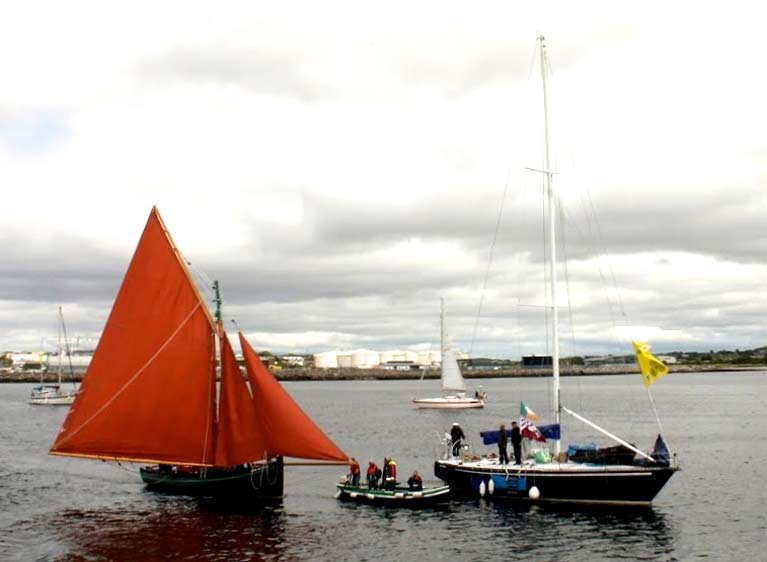 Lorient YC President Jean-Gab Samzun’s former Admiral's Cupper, the S&S 46 Trilogy (right), with Peter Connolly’s Galway Hooker from The Claddagh, which sailed out to the start off Galway to wish the fleet bon voyage. Photo: Patricia Cannon
Lorient YC President Jean-Gab Samzun’s former Admiral's Cupper, the S&S 46 Trilogy (right), with Peter Connolly’s Galway Hooker from The Claddagh, which sailed out to the start off Galway to wish the fleet bon voyage. Photo: Patricia Cannon
As the possible structures were being explored, research among potential participants was also underway for an event which was now set to come together with the Official Departure from Galway city on Friday, July 12th. In the greater Galway Bay area, Pierce Purcell had for some years been developing a list of all boats and boat-owners, a valuable database whose maintenance has now been taken over by GBSC’s Johnny Shorten. That provided a rewarding source of potential participants, but then it was found that others could soon be found beyond boats based within the limits set by Slyne Head, the Aran Islands, and Black Head.
In fact, potential cruisers-in-company were found all along the West Coast – the Wild Atlantic Way – and even round on to the south coast and Cork Harbour, while it extended inland with three entrants from Mountshannon and Garrykennedy on Lough Derg.
It’s the “hidden boats” of the westerns seaboard which provide the unexpected ingredient. For instance, anyone who is unfamiliar with the place, and arrives for the first time at Rosmoney, the base of Mayo Sailing Club hidden among the islands at the head of Clew Bay, will be pleasantly surprised by the size and quality of the cruiser fleet there. But then, Rosmoney is only “remote” for someone who lives outside Mayo. The thriving county town of Castlebar supports a significant boat-minded community, and so do many other places along the west and southwest coasts.
So although it’s quite a logistical challenge to commit yourself and your crewing recruits to an event which will involve sailing an absolute minimum of 1,106 mostly offshore miles by the time you’ve returned to Galway Bay, boats from as far north as Sligo signed up, as did one boat from Cork in the opposite direction. Indeed, such was the enthusiastic regional response that boats from Galway Bay SC itself, while still the largest club entry, have ended up in a minority of the fleet.
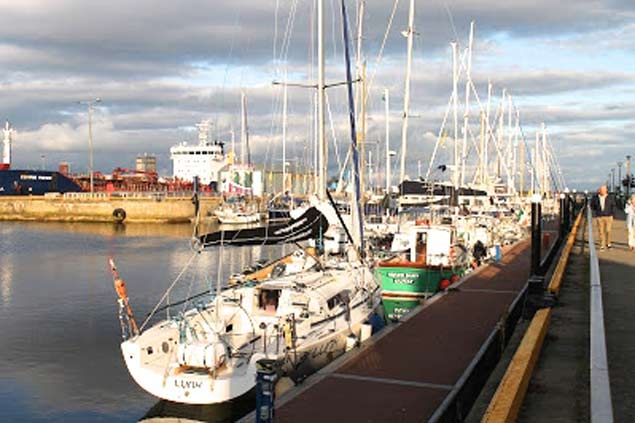 The most northerly-based participant, Dave O’Connor’s Reflex 38 Lynx from Sligo, in Galway Harbour before the start. Photo: Patricia Cannon
The most northerly-based participant, Dave O’Connor’s Reflex 38 Lynx from Sligo, in Galway Harbour before the start. Photo: Patricia Cannon
The entry list is intriguing, particularly when taken geographically north to south:
SLIGO YACHT CLUB
Lynx (Reflex 38): Dave O'Connor, Nigel Moss, Adam Sutor, Ian Tobin, Dennis Kashyn, Brian Moloney, Barry Shockly, Paddy Cassidy.
MAYO SAILING CLUB
Freebird (Achillles 9 Metre): Duncan Sclare, Maura Bourke Charles Scott.
Blue Moon: John Lambe
Carp Diem (Delphia 37): Brian Quinn, Sheila Molloy, Colin Wolfe
Coco (Jeanneau 42) J. McAllister
CLIFDEN SAILING CLUB
Moon River (Dufour 30): Rev. Anthony Previte
GALWAY CITY SAILING CLUB
Roamer (Contessa 32): Frankie Leonard, Frank Leonard Snr, Andraus Bauman, Fergal Diviney, Rob Talbot, Rian de
Bairead
Euphanzel III (Shipman 28): Gerry Moran
GALWAY BAY SAILING CLUB
Lean Machine (J/35): Cormac MacDonnacha. Dan King, Cathal Byrne, Eugene Osborne, Niamh Tyrell, Ken MacNamara
Imperator (Gladiateur 33): Tony Collins, John Shorten, Justin Shorten, Aonghus Concheanainn
Inis Bearachain (Sirius 38): Patrick & Connie Ryan, John Preisler, Eugene Burke
Feeling Groovy (Elite 36): Alan Lane, TJ Corcoran, Hugh Loftus, Con Brosnan
Rhocodar (Dehler 39): Tomas Furey, Aine Nolan, Lorraine Scully, Caroline Higgins, Tricia MacNamara. Grace Denny. Alan Donnelly
Stars are Out: Colm Moriarty
Yapper: Walter McInerney
INISCEALTRA SC
Seesaw: J Farrell
GARRYKENNEDY SC
Lisador (Dehler 36): Henry Hogg, Andy Flanagan, Sean Collins, Dan O'Donnell
Ocean Tango: Ollie Kierse . Steve Lynch
ROYAL WESTERN OF IRELAND YACHT CLUB
Sheenaun (Southerly 47): Louis Keating, Maeve Howard . Kathleen Nolan, Fergus Daly
Amergin: Pat O'Shea, Ruth O'Shea, Jim Lawlor.
ROYAL CORK YACHT CLUB
Split Point (Dufour 34): Seamus Gilroy
LORIENT YACHT CLUB
Trilogy III (S&S 46): Jean-Gab Samzun
Sunfast 36: (Guillermic)
Hallberg Rassy 42: (Bouyer)
Passade.
The project acquired a more thoughtful aspect after the French lifeboat accident in Storm Miguel in the Bay of Biscay on June 7th saw the loss of three lifeboatmen’s lives, and as already reported in Afloat.ie the Cruise-in-Company will carry messages of goodwill and condolences for the French rescue services from Galway Harbour Master Captain Brian Sheridan and the Galway RNLI.
As the start date approached, the pace became hectic with the three French boats arriving in from Brittany and those from north of Galway Bay (it’s 91 nm from Rosmoney) making their way south. It all started to become official on Thursday evening (July 11th) with a “Grand Fete de Departure” for all crew and their shoreside supporters – formal and otherwise – at the Harbour Hotel, with a perpetual trophy being presented by Phyllis Molloy, widow of the late Government Minister and former GBSC Commodore Bobby Molloy TD, to Gerry Moran, skipper of the smallest entrant, the Shipman 28 Euphanzel III, a boat type which Bobby Molly himself sailed back in the 1970s when links with Lorient were getting into their stride.
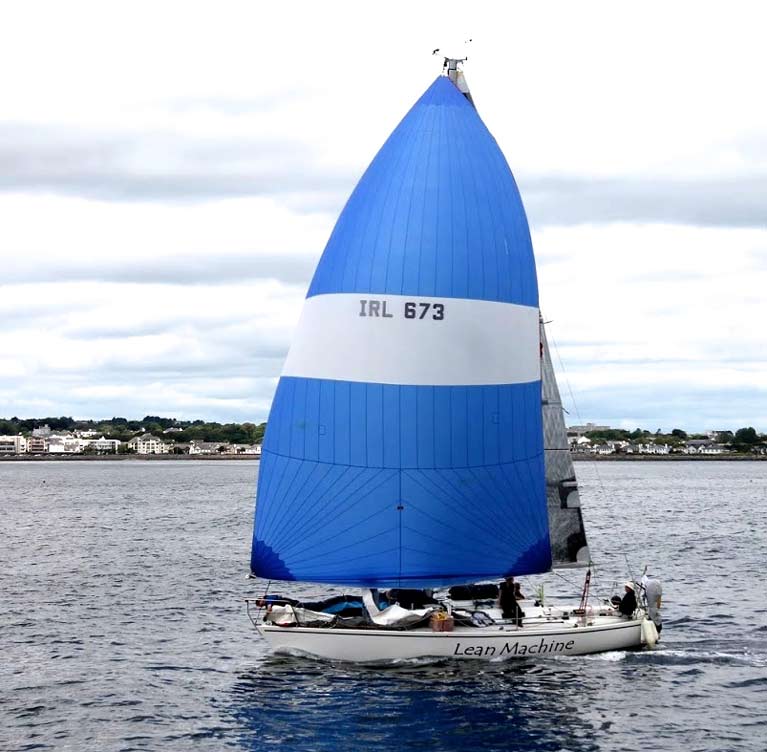 It may have been a Cruise-in-Company, but the J/35 Lean Machine (Cormac Mac Donncha) departed Galway in full racing mode. Photo: Patricia Cannon
It may have been a Cruise-in-Company, but the J/35 Lean Machine (Cormac Mac Donncha) departed Galway in full racing mode. Photo: Patricia Cannon
The send-off next evening was pure Galway, with traditional boat sailor Peter Connolly of the Claddagh coming out to the fleet to distribute goody-bags of turf and poitin for gifts to Brittany, and the departure was also saluted by Kinvara’s Cruinnui na mBad organizer Mick Brigan (the 40h Anniversary is August 9th to 11th 2019) with his king-size ketch-rigged Galway Hooker Mac Duiach, on his way to Roundstone to be in place for the Mac Dara’s Day traditional racing on Tuesday.
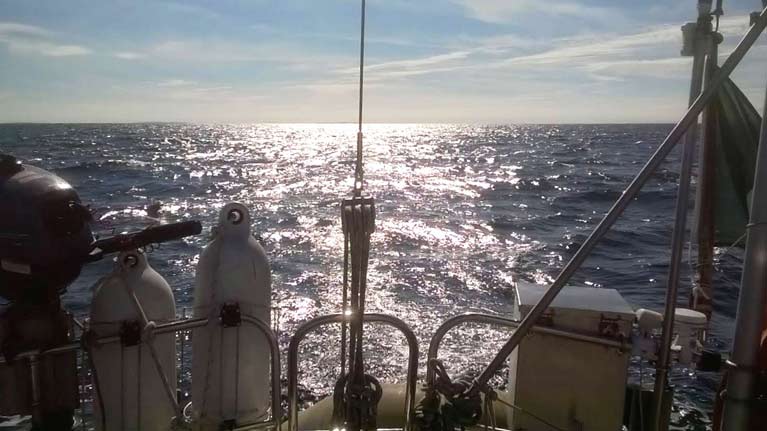 It was a good time to be heading south, with foul weather to the north of Ireland, yet conditions were like this for the Galway-Lorient Cruisers-in-Company in the Celtic Sea. Photo: Patricia Cannon
It was a good time to be heading south, with foul weather to the north of Ireland, yet conditions were like this for the Galway-Lorient Cruisers-in-Company in the Celtic Sea. Photo: Patricia Cannon
Conditions were gentle for progress around the southwest coast and the first stopover after making good 219 miles was at Kinsale, where the welcome was warm and the fleet achieved full size. Then it was away at dawn on Tuesday for a mostly light wind passage to Hughtown on St Mary’s in the Isles of Scilly (131 nm) where the fleet were in place by Wednesday morning as a weather frontal system went through to ensure that they’d have fair winds for the next stages.
By this time there were so many Galway boats in Hughtown that the Harbour Master Dale Clark wondered if any were left at home at all, and in honour of their presence he flew the GBSC burgee from the flagstaff on his launch, while before they left the Galwaymen gave him a special token of their thanks. But as ever the next port was calling, in fact some boats had availed of the good conditions to go on across the mouth of the English Channel to the very special island of Ushant where at least three boats – with Roamer and Feeling Groovy among them – had themselves a fine old time with GBSC Rear Commodore Johnny Shorten providing official approval.
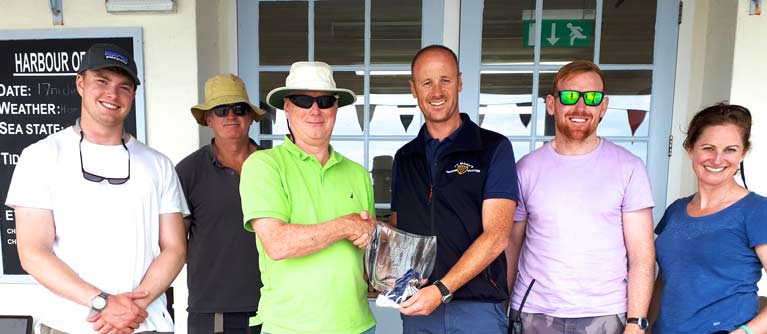 Cormac Mac Donncha, Fleet Organiser GBSC, making a thank-you presentation to Hughtown Harbour Master Dale Clark on Wednesday – left to right Cathal Byrne, Eugene Osborne, Cormac Mac Donncha, Dale Clark, Dan King and Niamh Tyrrell
Cormac Mac Donncha, Fleet Organiser GBSC, making a thank-you presentation to Hughtown Harbour Master Dale Clark on Wednesday – left to right Cathal Byrne, Eugene Osborne, Cormac Mac Donncha, Dale Clark, Dan King and Niamh Tyrrell
Back in Hughtown meanwhile, organizer Cormac Mac Donncha with his J/35 Lean Machine found himself in the Good Shepherd role. It was 2300hrs on Wednesday evening before he was certain that all his flock were well on their way southwards or otherwise safely accounted for, and then he took his farewell of the friendly Isles of Scilly and Lean Machine went to sea as the tail-ender in the procession to South Brittany.
According to the programme, the next stop was to be Ile de Groix, though some thought they’d see the full hop to Lorient put astern before really relaxing. Whatever, the weather during the past couple of days has been generally better south of Ushant and winds have been providing a beam reach, so even if there’s been the occasional spot of rain, the underlying trend has been in the right direction for the time being.
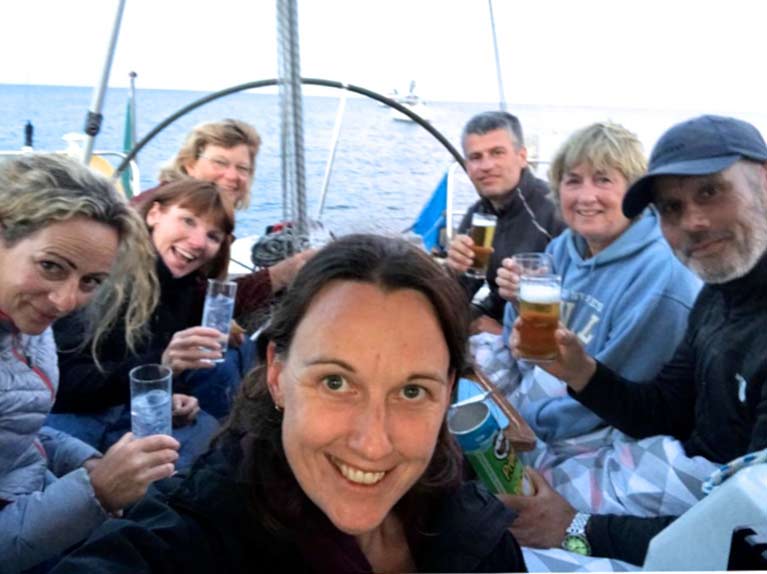 We’re here! The crew of Rhocodar in celebratory mood in the open anchorage at Ushant are (left to right) Tricia MacNamara, Grace Denny, Aine Nolan, Lorraine Scully, Tomas Furey, Caroline Higgins and Alan Donnelly. Photo: Lorraine Scully
We’re here! The crew of Rhocodar in celebratory mood in the open anchorage at Ushant are (left to right) Tricia MacNamara, Grace Denny, Aine Nolan, Lorraine Scully, Tomas Furey, Caroline Higgins and Alan Donnelly. Photo: Lorraine Scully
In any case, with even the relative beginners finding more confidence with every mile sailed, trying to keep to a close schedule and itinerary becomes increasingly difficult. In fact, it’s like herding cats, so space had been left in the programme for diversions such as that made to Ushant, which Tomas Furey’s Dehler 39 Rhocodar crew much enjoyed, and they then went on to Concarneau with Frankie Leonard’s Contessa 32 Roamer, where an entertaining contact was made with the one and only Tom Dolan.
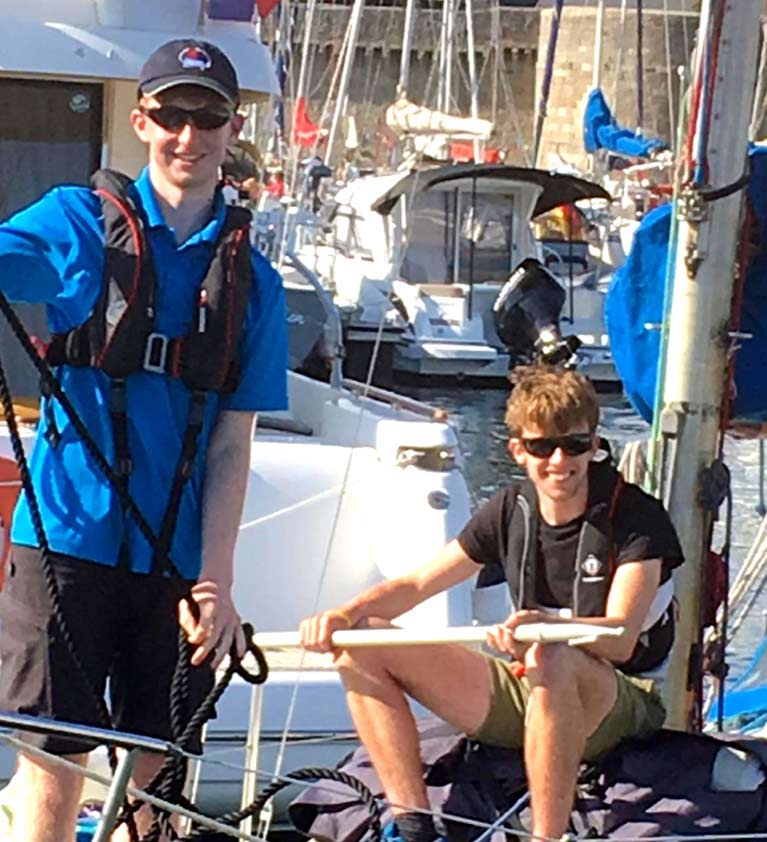 Young voyagers. Rian de Baraid and Rob Talbot on Frankie Leonard’s Contessa 32 Roamer (Galway City SC) after reaching Concarneau. Photo: Lorraine Scully
Young voyagers. Rian de Baraid and Rob Talbot on Frankie Leonard’s Contessa 32 Roamer (Galway City SC) after reaching Concarneau. Photo: Lorraine Scully
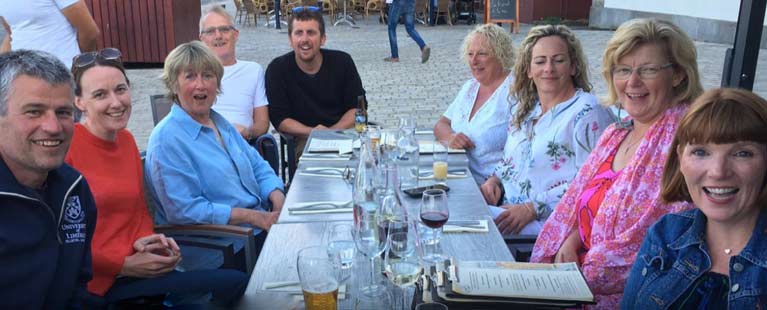 Local hero. Tom Dolan with the crew of Rhocodar at Concarneau. Photo: Lorraine Scully
Local hero. Tom Dolan with the crew of Rhocodar at Concarneau. Photo: Lorraine Scully
Today, all being well, those still in the fleet will be assembling at Port Tudy in the Ile de Groix, and then they’ll set off in formation at 4 pm to arrive in Lorient at 6 pm, where they’ll find much of interest including the Galway Inn where the word is they’re ready and waiting. And as their fleet berth is in Kermevan where the legendary U-Boat Pens are reminders of another aspect of Lorient’s history (think of the superb war movie Das Boot), they’ll find much to compare with home.
For the reality is that when Galway was already a tough, compact and very complete little walled city punching way above its weight, what is now Lorient was only a sparsely populated collection of cottages considered of little significance. Things have changed more than somewhat since then.
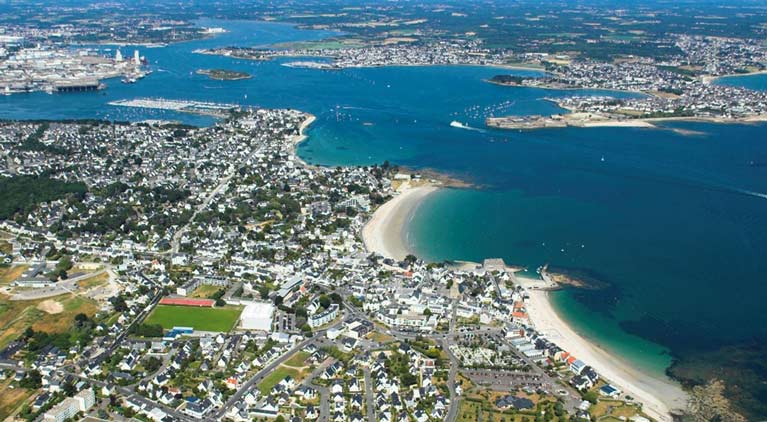 Lorient today – a place of multiple facilities and considerable significance
Lorient today – a place of multiple facilities and considerable significance
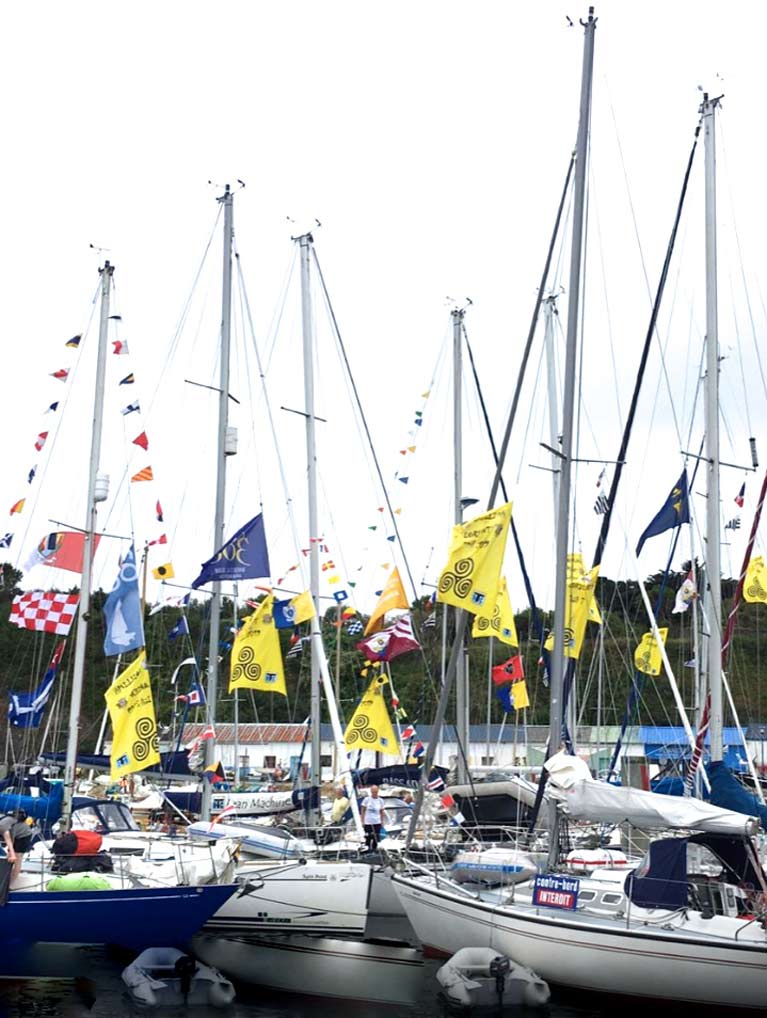 Ready to make their arrival – part of the Galway fleet in the Ile de Groix this morning, flags flying for the final short hop across to their Lorient reception this evening. Photo: Lorraine Scully
Ready to make their arrival – part of the Galway fleet in the Ile de Groix this morning, flags flying for the final short hop across to their Lorient reception this evening. Photo: Lorraine Scully
As open water sea swimmers prepare for a Galway Bay crossing this weekend, Irish Water has said there is “no proven link” between a recent serious pollution incident in the city and the quality of bathing water off Galway’s beaches writes Lorna Siggins
However, swimmers have called for more regular and longer-term bathing water quality testing, and more transparency in relation to water quality issues.
Six weeks ago, Galway City Council prohibited swimming off beaches at Silver Strand and Salthill and issued a warning about Grattan road beach in Lower Salthill, after elevated levels of bacteria were detected.
The prohibitions were lifted in time for the June bank holiday weekend, and the city council initially ruled out several possibilities, including Mutton Island sewage treatment plant, visiting cruise ships and slurry spreading run-off.
It subsequently stated that the elevated levels of bacteria were due to a fault with the test.
A month later, on July 5th, Galway harbourmaster Capt Brian Sheridan stated in response to media queries that “the current sewage issue is not as a result of port operational activities, including cruise ships that anchor in the bay”.
Galway Bay is a popular destination for cruise ships, which are covered by the international MARPOL regulations. Vessels from another flag state can only discharge treated sewage at least three nautical miles from the nearest land or untreated sewage at least 12 nautical miles from the nearest land.
Capt Sheridan stressed that he issued Galway Port Company’s own prohibition notices, stating that ships must be at least 12 nautical miles west of the Aran islands.
Capt Sam Field Corbett, who owns the old dock known as the “Mud docks” in the inner Galway harbour, said he believed the source of contamination could be linked to a sewage overflow, which he first reported to Galway City Council in March, and to the Environmental Protection Agency (EPA) in early May when there was no action.
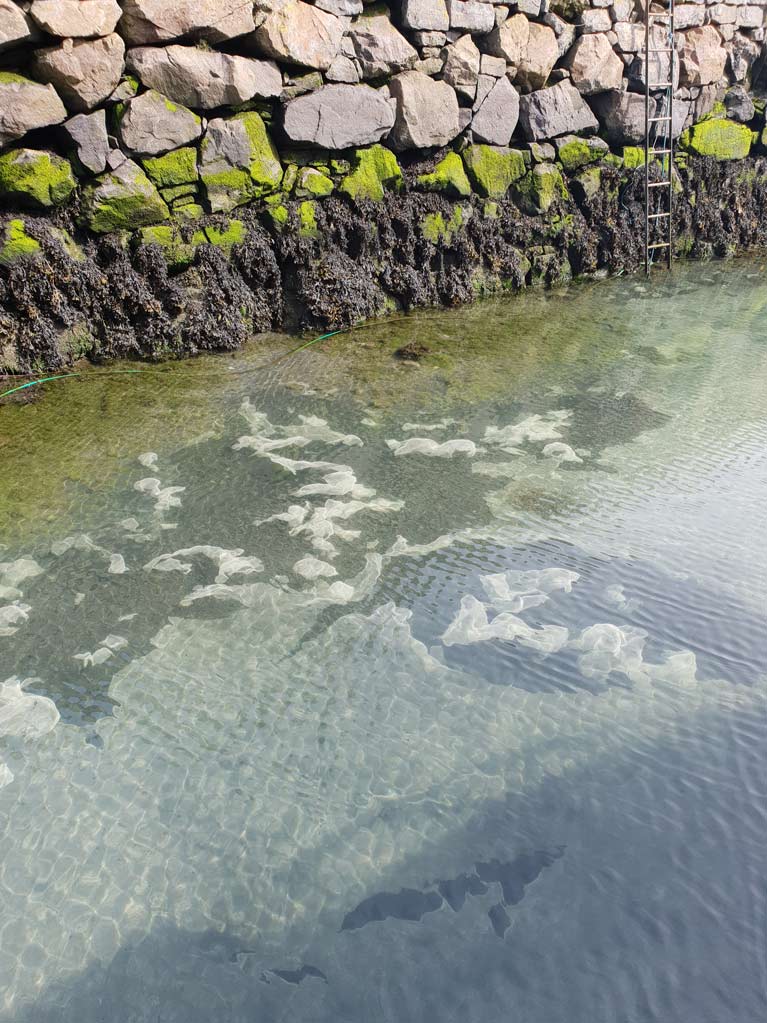 Capt Sam Field Corbett sent this photo to the EPA in May. Corbett says it depicts evidence of sewage and waste at low tide in the Galway city mud dock
Capt Sam Field Corbett sent this photo to the EPA in May. Corbett says it depicts evidence of sewage and waste at low tide in the Galway city mud dock
On May 15th, he informed the EPA that it appeared the sewage had stopped flowing, but evidence of human waste was still present in what he described as “once a thriving eco-system”
On June 14th, Irish Water announced that it was upgrading one of Galway’s Victorian sewer systems, which would address “odour and blockage issues” , as part of a 2 million euro project with Galway County Council due for completion in October.
Irish Water has confirmed that a sewer blockage had caused an overflow at the Mud Docks, and this was “cleared”, and a pipe in Eyre Square repaired.
It said that RPS consultants were separately conducting survey works across the entire Galway city network.
“There is no proven link to the issue at the Mud docks and any issues arising at the bathing waters in Galway city in late May,”Irish Water said, noting that all data reported to date during the 2019 bathing water season in Galway city had been classified as “excellent” or “good”.
Galway sea swimmer Brian Coll, who is undertaking the Frances Thornton Memorial Galway Bay Swim in aid of Cancer Care West this weekend with his family, said he believes there needs to be more frequent water quality testing from April to October.
"The current situation where bathing water quality is tested every two weeks is insufficient, given that Salthill has one of the most active sea swimming communities in Ireland," he said.
"There needs to be weekly water testing and also more active environmental monitoring for visiting cruise ships. This is standard in other cruise ship destinations such as Alaska and Norway, where there are regular checks for any discharges of sewage and wastewater from the ships,” he said.
“We need to have confidence in the quality of our bathing water,” Mr Coll noted.
Sampling of bathing water only needs to take place once a month between May and September under the 2006 EU Bathing Water Directive, but the EPA says some local authorities test more frequently.
The directive is going to be reviewed, and frequency of testing may form part of this, but the review is at its early stages.
Galway City Council's Environment Department said that bathing water quality testing is carried out in accordance with a schedule agreed in advance with the EPA.
"For Blue Flag beaches this is every fortnight and for other beaches this is every week. Once the sample is taken it takes 48 hours for the test to react and as soon as these results are received they are published. Therefore they are published within 48 hours of the test but the test is carried out every two weeks for Salthill and Silverstrand. This is exactly the same frequency any other Blue Flag beach in the country," it said.
Galway City Council says it tests every second week. Results of bathing water quality testing on frequently used beaches around the coastline are posted on the EPA’s website, beaches.ie
Three French lifeboat crew who died in a recent sea rescue will be remembered by a fleet of west of Ireland sailing craft setting sail from Galway for the Breton port of Lorient later this week writes Lorna Siggins.
Bearing sods of turf, the “cruise in company” involves some 30 yachts and classic craft, including the Galway Hooker MacDuach.
As Afloat previously reported in May, French honorary consul Catherine Gagneux will be in Lorient to greet the fleet, leaving Galway on Friday (July 12) and expected on or about July 20th/21st, weather permitting.
The fleet from Mayo, Galway, Clare, Cork and further afield will fly “battle flags”. Celebrations are planned to mark almost 45 years of a twinning between Galway and Lorient.
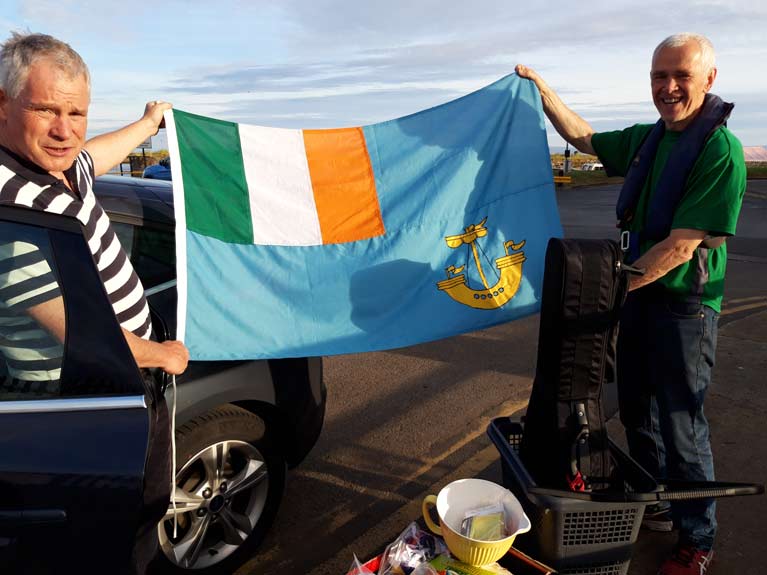 Johnny Shorten and Tony Collins (left to right) of Galway Bay Sailing Club Photo: Catherine Gagneux
Johnny Shorten and Tony Collins (left to right) of Galway Bay Sailing Club Photo: Catherine Gagneux
Ms Gagneux says the voyage is particularly significant, as one of the craft will sail with a signed flag from Galway rescue volunteers to honour three French lifeboat crew who died recently in Sables d’Olonne, some 100 km north of La Rochelle.
A letter of condolences from Galway harbourmaster Capt Brian Sheridan will also be presented to the Groix Island Sea Rescue, near Lorient.
The French crew members were part of the rescue organisation, Société Nationale de Sauvetage en Mer which went to the aid of a fishing vessel during Storm Miguel on June 7th.
The lifeboat capsized due to severe weather conditions, which saw winds of up to 120 km per hour. Four of the seven crew were able to swim ashore.
The Galway-Lorient cruise was initiated by Enda O Coineen, along with Cormac Mac Donncha from ThermoKing in Galway, and Jean-Gab Samzun, the president of the Lorient Galway association - also known as a real 'Vieux Loups de Mer' (Old Sea Dogs ), Ms Gagneux explains.
Sailing fleets from both Galway and Lorient had participated in a number of events in the 1970s, and 1980s and the aim of the “Great Celtic Cruise Adventure” is to revive this tradition.
The 1100 nautical mile return voyage - 550 nautical miles each way - will have three stopovers in Kinsale, Co Cork, for Bastille Day on July 14th; the Scilly Isles; and Ile de Groix.
Mr MacDonncha says that the bags of turf were requested by “Celtic cousins” in Brittany to commemorate the role of working boats such as the Galway hookers who delivered such cargo to the Aran Islands and along the west coast before electricity and diesel were used to heat homes.
Mr Samzun will lead the fleet, along with Galway Bay Sailing Club vice-commodore and voyage organiser Johnny Shorten.
Ms Gagneux says that further social, economic and cultural projects will mark 45 years of the Galway-Lorient relationship in September 2020.
The Frances Thornton Memorial Galway Bay Swim in aid of Cancer Care West returns to the waters of Galway Bay this July.
Now in its 14th year, the now sold-out event on Saturday 20 July will see close to 130 swimmers taking part this year in one of Ireland's biggest and longest one-day swims.
Starting from Aughinish in Co Clare and finishing at Blackrock diving tower in Salthill, where the recent swim ban has just been lifted, the swim is a distance of roughly 13 kilometres — if you swim in a straight line.
This year there will be 69 solo swimmers as well as 65 relay swimmers taking part in teams of two, three and four.
Since the swim began 14 years ago, 740 people have swam the bay and this year again it will be a mixture of swimmers who have completed the swim every year and complete novices.
Last year’s swim raised over €100,000 for Cancer Care West and it’s hoped to beat that target this year.
The monies raised will help fund the expansion of support services for cancer patients, including a counselling service for children and a dedicated gym rehabilitation space for cancer patients.
Safety is a priority for the swim, and each year the event reaches out to the maritime community in the west to support the swim through boat support.
Ciaran Oliver of Galway Bay Boat Tours and Oranmore Maree Coastal Rescue are helping out again this year.
Each swimmer needs a boat to follow and track their swim, so organisers are again this year asking any boat owner to get in contact with the hope they can volunteer their services on the day.
The most suitable boat is a 5m RIB with a 50HP engine or equivalent.
“Ideally we are looking for motor boats, pleasure crafts between five and seven metres, however we are urging people to get in touch and we can then pull together resources from what we have and ensure that this swim is again a safety success,” Ciaran Oliver said.
The Frances Thornton Memorial Galway Bay Swim will take place on Saturday 20 July. Spectators are invited to go down to Blackrock diving tower in Salthill to welcome the swimmers home from noon.
To volunteer or for more details visit the official website and Facebook page, or contact Dave O’Donnell on 087 908 8587.
Galway Swim Ban Lifted
A swim ban has been lifted at Galway city’s beaches, following the latest results of bathing water quality tests writes Lorna Siggins
Galway City Council has removed “do not swim” notices at Silver Strand and Salthill beaches on the advice of the Health Service Executive (HSE).
As Afloat previously reported, a ban had been imposed last Wednesday (May 29) on Silver Strand, Salthill and at Blackrock diving board, after very high levels of an intestinal enterococci bacteria were detected during routine testing early last week.
The bacteria may cause illness.
An advisory notice to warn swimmers was also posted at Grattan road beach, where levels were lower.
Galway City Council confirmed on Saturday afternoon that following re-testing of bathing water, results were “positive”.
“The HSE has advised that the prohibition notices on Blackrock and Silverstrand bathing areas may be removed with immediate effect,” it said.
The local authority did not confirm the cause of the pollution. Last week, a spokesman said it was also investigating whether the tests were faulty.
Several sources, such as Mutton island sewage treatment plant and a visiting cruise ship, were ruled out by the city council.





























